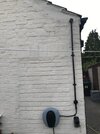Hi,
Had a Pod Point EV charger installed and just wanted some confirmation with regard the safety of the installation. I have a 6mm T&E cable running from the consumer unit which is jointed on the outside wall to another high load cable as it goes down to the charger as per the pic.
I question the joint of the 2 cables which are tightly packed in the circular plastic box at the top of the wall as shown in the pic. I raised the question at the time with the electrician and he assured me that everything was fine and its all been signed off. It all seems watertight as you look at it but I do know that the cable coming through the wall has been punched through the back of this box. I must admit, that I expected the jointing box to be a more substantial waterproof affair considering they are high load cables.
Anyway, grateful for any feedback from you guys.
Had a Pod Point EV charger installed and just wanted some confirmation with regard the safety of the installation. I have a 6mm T&E cable running from the consumer unit which is jointed on the outside wall to another high load cable as it goes down to the charger as per the pic.
I question the joint of the 2 cables which are tightly packed in the circular plastic box at the top of the wall as shown in the pic. I raised the question at the time with the electrician and he assured me that everything was fine and its all been signed off. It all seems watertight as you look at it but I do know that the cable coming through the wall has been punched through the back of this box. I must admit, that I expected the jointing box to be a more substantial waterproof affair considering they are high load cables.
Anyway, grateful for any feedback from you guys.


